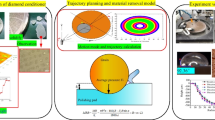Abstract
Diamond dressing process is critical in conditioning pad surface topography before and after chemical mechanical planarization/polishing (CMP) process for integrated circuit (IC) fabrication. This paper addresses a kinematic model of diamond dressing effect on the profile of pad cutting rate (PCR) with a ring-type diamond dresser through both simulation and experiments. In this kinematic model, the cutting locus distribution, relative velocity of diamond grits on a pad surface, and sliding time have been described as significant factors for non-uniformity of pad surface topography. Moreover, the speed ratio between the diamond dresser and the polishing pad has been investigated with respect to the center distance of the pad and the diamond dresser by the developed method. The model has been verified by experiments of diamond dressing of pad. Experimental results show that the dressing marks and pad cutting rate on the pad surface follow the same trend as simulation results and the final pad surface is obtained as a concave shape. Results of this study can be applied on diamond dressing of pads used in CMP and furthermore can be extended to investigate an optimal diamond dressing process for semiconductor fabrication.
Similar content being viewed by others
References
Chen C-CA, Shu LS, Lee SR (2003) Mechano-chemical polishing of silicon wafers. J Mater Process Tech 140(1-3):373–378. doi:10.1016/S0924-0136(03)00827-6
McGrath J, Davis C (2004) Polishing pad surface characterization in chemical mechanical planarization. J Mater Process Tech 153:666–673. doi:10.1016/j.jmatprotec.2004.04.094
Shi H, Ring TA (2010) CMP pad wear and polish-rate decay modeled by asperity population balance with fluid effect. Microelectron Eng 87:2368–2375. doi:10.1016/j.mee.2010.04.010
Tso PL, Hsu R (2007) Estimating chemical mechanical polishing pad wear with compressibility. Int J Adv Manufac Technol 32:682–689. doi:10.1007/s00170-005-0386-1
Kim S, Saka N, Chun JH (2014) The role of pad topography in chemical-mechanical polishing. IEEE Trans Semicond Manuf 27(3):431–442. doi:10.1109/TSM.2014.2335156
Kim S, Saka N, Chun JH (2014) The effect of pad-asperity curvature on material removal rate in chemical-mechanical polishing. Procedia CIRP 14:42–47. doi:10.1016/j.procir.2014.03.014
Lee H, Zhuang Y, Sugiyama M, Seike Y, Takaoka M, Miyachi K, Nishiguchi T, Kojima H, Philipossian A (2010) Pad flattening ratio, coefficient of friction and removal rate analysis during silicon dioxide chemical mechanical planarization. Thin Solid Films 518(8):1994–2000. doi:10.1016/j.tsf.2009.07.193
Kim HJ, Jeong H (2004) Effect of process conditions on uniformity of velocity and wear distance of pad and wafer during chemical mechanical planarization. J Elec Mater 33(1):53–60. doi:10.1007/s11664-004-0294-4
Park KH, Kim HJ, Chang OM, Jeong HD (2007) Effects of pad properties on material removal in chemical mechanical polishing. J Mater Process Tech 187–188:73–76. doi:10.1016/j.jmatprotec.2006.11.216
Wang C, Sherman P, Chandra A, Dornfeld D (2005) Pad surface roughness and slurry particle size distribution effects on material removal rate in chemical mechanical planarization. CIRP Ann Manuf Technol 54 (1):309–312. doi:10.1016/S0007-8506(07)60110-3
Chen C-CA, Hsu LS, Hsu CK, Liu WC (2002) Study on pad dressing process for CMP of silicon wafers. In: Proceedings of the third international conference of european society of precision engineering and nanotechnology. Eindhoven, (EUSPEN 2002)
Hocheng H, Huang YL, Chen LJ (1999) Kinematic analysis and measurement of temperature rise on a pad in chemical mechanical planarization. J Electrochem Soc 146:4236–4239. doi:S0013-4651(99)02-045-5
Hocheng H, Tsai HY, Tsai MS (2000) Effects of kinematic variables on nonuniformity in chemical mechanical planarization. Int J Mach Tools Manuf 40:1651–1669. doi:10.1016/S0890-6955(00)00013-4
Tyan F (2005) Non-uniformity of wafer and pad in CMP kinematic aspects of view. Amer Control Conf (Portland) 3:2046–2951. doi:10.1109/ACC.2005.1470271
Li ZC, Baisie EA, Zhang XH (2012) Diamond disc pad conditioning in chemical mechanical planarization (CMP): a surface element method to predict pad surface shape. Precis Eng 36 (2):356–363. doi:10.1016/j.precisioneng.2011.10.006
Chang O, Kim H, Park K, Park B, Seo H, Jeong H (2007) Mathematical modeling of CMP conditioning process. Microelectron Eng 84(4):577–583. doi:10.1016/j.mee.2006.11.011
Nguyen NY, Zhong ZW, Tian YB (2014) An analytical investigation of pad wear caused by the conditioner in fixed abrasive chemical–mechanical polishing. Int J Adv Manuf Technol 77(5):897–905. doi:10.1007/s00170-014-6490-3
Yeh HM, Chen KS (2010) Development of a pad conditioning simulation module with a diamond dresser for CMP applications. Int J Adv Manuf Technol 50(1):1–12. doi:10.1007/s00170-009-2488-7
Simončič S, Podržaj P (2016) An enhanced algorithm for estimation of a digitized curve length using B-splines. Measurement 94:168–76. doi:10.1016/j.measurement.2016.07.082
Chen C-CA, Pham QP (2016) Kinematic model and simulation of pad dressing process by sweep arm mechanism. Proc Cross-strait Asia-Pac Chem Mech Planar Conf Taiwan (APWCMP2106) 2016:115–124
Author information
Authors and Affiliations
Corresponding author
Rights and permissions
About this article
Cite this article
Chen, CC.A., Pham, QP. Study on diamond dressing for non-uniformity of pad surface topography in CMP process. Int J Adv Manuf Technol 91, 3573–3582 (2017). https://doi.org/10.1007/s00170-017-0060-4
Received:
Accepted:
Published:
Issue Date:
DOI: https://doi.org/10.1007/s00170-017-0060-4



